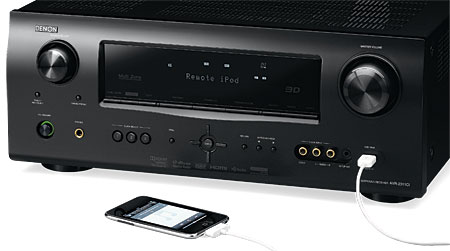Denon AVR-2311CI A/V Receiver Page 2
Denon likes a highly functional front panel. The AVR-2311CI’s includes a set of menu navigation controls. That’s unusual enough. Not hiding the nav controls behind a flip-down panel is even more unusual. To the left is a trio of Quick Select buttons that pick not only the input, but volume, surround mode, Audyssey setting, and video select (which assigns another input’s video to an audio input to keep your screen from getting bored). Skinny horizontal buttons right below the display adjust various Audyssey settings, zone selection, and iPod play.

The Quick Select, iPod Play, and Audyssey controls are repeated on the remote. Denon’s attention to ergonomic detail makes this AVR easier to use than many others that have the same basic feature set.
Denon’s user interface is up to date with decent graphics and organization. Its remote is modest but above average in organization of the controls by color, shape, and layout. I was especially pleased to encounter the remote’s dedicated buttons for the Audyssey features (MultEQ, Dynamic EQ, Dynamic Volume). That makes it much easier to make before-and-after comparisons to determine how this AVR can serve you best. The manual combines a Simple Version, a Basic Version, and an Advanced Version between a single set of covers—in three languages, of course. An A/V receiver is always a complex beast, but Denon seems determined to make the best of a difficult situation.
Associated equipment included five Paradigm Reference Studio 20 v.4 speakers, Paradigm Seismic 110 sub (run without its own EQ), OPPO BDP-83SE universal disc player, Rega Planar 25 turntable, Shure M97xE cartridge, and Onix OA 21S integrated amp serving as phono preamp. All movies were Blu-ray Discs with DTS-HD Master Audio soundtracks.
 Postprocessing Distress Relief
Postprocessing Distress Relief
Triage sends Colin Farrell to the Kurdish region as a war photographer, then brings him home as a sufferer of post-traumatic stress disorder. For a war movie, it’s surprisingly dominated by quiet moments of dialogue. But I still wanted to be shielded from the louder ones, so I selected the Day (lightest) setting of Audyssey Dynamic Volume (used, as always, in tandem with Dynamic EQ). This brought the soft and loud moments into a more tolerable balance, although I still fiddled a little with the master volume to catch all of the dialogue that Farrell delivers in his fast-talking Irish accent. An exploding car showed that Audyssey MultEQ had done an excellent job of dialing in the sub. The orchestral score’s vividness also struck me; the strings sounded mildly acerbic, not bland.
Pirate Radio is a celebration of the offshore, boat-borne, unofficial radio stations that regaled Britain with rock in the mid-’60s when the BBC refused to play it. Despite incandescent comic performances by Philip Seymour Hoffman and Kenneth Branagh, the real stars are the British Invasion rock classics from the Kinks, the Who, etc. What was interesting was the way the music—much of it recorded in mono—was mixed according to the mood of the moment, ranging from quiet background to full-frontal, all-channel euphoria. I’ll never listen to “All Day and All of the Night” by the Kinks in the same way again. I stuck with Audyssey Dynamic Volume’s Day mode and didn’t regret it.
Friday Night Lights is the movie (not the TV show) with Billy Bob Thornton as the coach of a West Texas high school team with a devouring passion to win a state championship. This isn’t a typical feel-good football movie. Based on real people and events, it cuts close to the bone. I found that my emotional reaction to it varied according to where I set Audyssey Dynamic Volume. With Dynamic Volume off, the soundtrack was almost unbearably confrontational. The Day mode wasn’t much easier to take. The Night mode was a smoother ride, but it also distanced me from the story. The Midnight mode provided the easiest listening, but in a way the filmmakers surely didn’t intend. There was no right setting—just a different set of compromises with each one.
Interstellar Bruckner
For my music demos, I switched off Audyssey Dynamic EQ/Volume to allow the full dynamic range of various high-resolution music formats to come through. However, I left MultEQ in the circuit, as I’ve come to trust it over the years, even with revealing orchestral material.
- Log in or register to post comments
























































